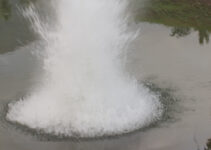Have you ever encountered a Goliath grouper while snorkeling or SCUBA diving? How does it look like? How do these magnificent fishes reproduce? Are they really big as their name “Goliath” suggest? Are they aggressive? This article answers these questions. Read on and learn about the Goliath grouper.
During one of my SCUBA diving spree in Apulit Island, a popular tourist destination north of Palawan Island in the municipality of Taytay, I met the Goliath grouper. I learned about it from a buddy diver who excitedly told me to go diving with him upon a prompt from a classmate in high school who happened to be the mayor of that town. That day actually was our high school reunion day in that isolated, white-beach a few nautical miles from the town proper.
Probably, I am lucky that the Goliath grouper (Epinephelus quinquefasciatus) I encountered several minutes when I plunged into the water was still a juvenile. But it’s already unusually bigger than the common reef fish I see.
Behavior of Goliath Grouper
I brought with me my automatic Nikon camera encased in a plastic casing to make it water-resistant as taking pictures is a pleasure for me each time I travel. I grabbed the camera hanging by a tough nylon string around my wrist, and took a video of the Goliath grouper following my buddy. Midway the video, a grouper swam by my side then approached me with another one. You can see it below:
How big can Goliath groupers get? The ones above are just juveniles or young ones that could grow to as long as six feet. And they could weigh more than 300 kilograms! The one I saw was about two feet long.
Despite the huge size of the Goliath grouper, they seem to be docile fishes although there are reports that they do attack humans. I saw one video that says so but analyzing the situation, I thought the reason was mainly to feed, not really to attack. Here’s the video of that alleged Goliath grouper attack:
Do you agree with my observation? The moving fins attracted the grouper thinking probably that it was its prey and snapped on it. The prey was the speared fish, not the SCUBA diver who is holding the spear with the fish. It is also possible that the Goliath grouper thought the man as its competitor thus snapped on the competitor’s “tail” and swam away with its booty.
What is the life cycle of the Goliath grouper?
Goliath groupers rely on the protection of the mangrove forests because after their eggs hatch, they settle in the mangrove litter and roots. Thus, the mangroves are crucial in their survival because mangroves serve as microhabitats that prevent predators from eating the very young juveniles. When the juveniles are older, they migrate to the coral reefs and stay there for more than 40 years. When they are old enough to reproduce, the Goliath groupers migrate and spawn into the deeper water column, fertilize the eggs which then are carried by the current, hatch then drift in the currents for 30 to 80 days (Fig. 1).

The cycle shows that everything is connected to everything else. If something disastrous like oil spill that kills the larvae of fish like the Goliath grouper or makes the mangroves unfit for habitat to fish, then there will be lesser fish available for people to see and enjoy (if they are SCUBA diving or snorkeling tourists) and consume. I wouldn’t have seen the Goliath grouper at all.
The nearshore environment is a fragile one that should be protected or conserved considering the highly complex life that intertwine in mangrove ecosystems. The Goliath grouper is only one of the rich diversity of life that support man.
©2014 November 26 Patrick Regoniel



Horrible this did not help with a project at all
Aren’t they a protected species???
Superb! Keep on writing amazing creatures.